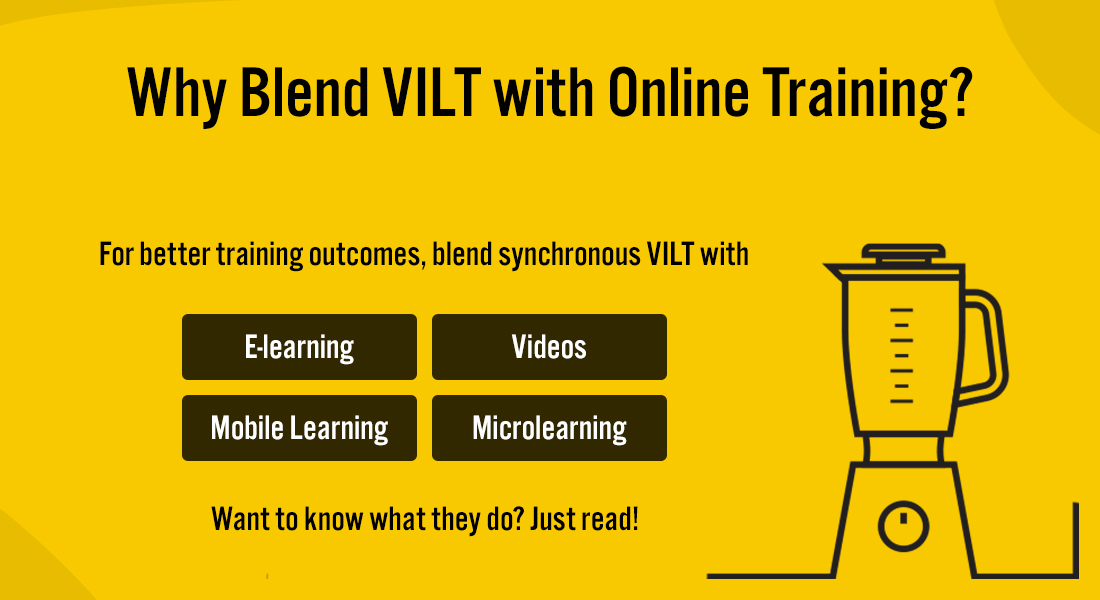How to Reimagine Your Corporate Training with Virtual Instructor-led Training

The emergence of eLearning has ignited a change in the business world, with thousands of organizations adopting new digital methodologies. As a result, remote and hybrid models have become the new norm. For years, companies have relied on in-person training to upskill employees. However, there’s an increased need for an alternative solution, one that facilitates remote and hybrid environments while providing the personal touch of traditional classroom training. VILT (Virtual Instructor-Led Training) is one such methodology that can be instrumental in this scenario.
This innovative approach is resulting in a paradigm shift in how organizations approach corporate training. By facilitating training from anywhere, VILT offers a more flexible solution in terms of cost and implementation.
Reimagine your Corporate training session with VILT
VILT helps in:
- Obtaining expert advice
- Enabling memorable learning experiences
- Measuring Performance
- Allowing Cost-Effective Courses
- Empowering Continual Learning
Read on to explore the benefits of VILT.
With that said, let’s dive deeper and explore the crucial factors of Virtual Instructor-Led Training and some of its key benefits.
How VILT Fits into the Modern Corporate Sector
VILT is a type of online training method in which learners such as interns, employees, and C-level executives as well as instructors such as managers, leaders, third-party subject-matter experts, and coaches interact on a virtual video-conferencing platform. At its core, VILT is the online version of traditional instructor-led classroom training.
Get to know all about Classroom to VILT conversion.
The most popular platforms used to conduct VILT sessions include Zoom Meetings, Microsoft Teams, Google Meet, Cisco, Slack, and Webex, just to name a few. Here’s how these sessions fit into the modern corporate sector:
- VILT enables real-time interaction between learners and instructors.
- VILT enables access to training from any location worldwide.
- VILT enables more interaction than online courses.
- VILT instructors help break down complex concepts.
Virtual Instructor-Led Training vs. eLearning
eLearning courses are structured training materials and instructions delivered to learners electronically. A typical course comprises an array of elements, including short videos, quizzes, games, pre-recorded lectures, and activities – all of which can be accessed through an LMS (Learning Management System).
While eLearning offers some incredible benefits to both learners and instructors, it doesn’t offer the experience of real-time interaction. VILT is the virtual counterpart of classroom instruction. Therefore, any information exchange or focus isn’t limited to a specific topic or audience. Many organizations use VILT for a more in-depth training experience as well as combine it with eLearning courses.
Key Benefits of Virtual Instructor-Led Training
VILT keeps traditional classroom training alive and relevant as the corporate world transitions rapidly towards self-service online courses. It helps maintain the human factor in training by enabling engagement between learners and SMEs (Subject Matter Experts). Here are some of the main benefits of VILT:
1. Obtaining Expert Advice
One of the most important benefits VILT offers learners is the quick access to quality advice from subject-matter experts, be it upper management or a third-party solution specialist. This approach helps organizations enhance the learning process by enabling engagement and collaboration. Some employees prefer interacting with the instructors as opposed to completing self-paced eLearning courses online.
2. Enabling Memorable Learning Experiences
VILT also helps trainers by creating an immersive learning environment. It offers learners a smart way to retain knowledge by providing training both practically and theoretically. It also improves participation enabling learners to get more involved by engaging with their instructors and colleagues. Popular activities in VILT include brainstorming, role-playing, and group discussions.
Trainers can also incorporate eLearning tools such as quizzes, videos, and scenarios as it helps learners refresh their learning as and when required. Another strategy to engage learners is through the use of breakout rooms that have become increasingly popular ever since Zoom Meetings came on the scene.
Breakout rooms allow instructors to split their meetings into approximately 50 separate sessions and thereby into smaller audiences per session in order to improve collaboration and participation. For instance, instructors can break the training session according to the organization’s departments. They can further organize their sessions into separate training sessions and days earmarked for the marketing, sales, manufacturing, and customer service departments.
3. Measuring Performance
In most traditional classrooms, tracking and measuring performance can be incredibly difficult, especially with core business activities happening simultaneously. Virtual Instructor-Led Training allows trainers to adjust and improve the training sessions according to their learners’ availability, preferred time slots, and skill sets. More importantly, they can easily analyze and track the learners’ performance through up-to-date reports on Learning Management Systems.
Many trainers also employ virtual quizzes, polls, or projects to determine the effectiveness of the training.
4. Allowing Cost-Effective Courses
VILT is relatively more cost-effective when compared to traditional classroom training as well as eLearning courses. Unlike in-person instructor-led training, VILT helps companies save a fortune on logistics. Similarly, learners can attend sessions remotely thereby avoiding transportation costs.
Moreover, trainers don’t have to worry about training material as most aspects of VILT are digitalized.
5. Empowering Continual Learning
Perhaps, the most important benefit of VILT is continual learning. By equipping employees with digital libraries, videos, and books businesses can employ instructors to deliver instructions virtually anytime and from any location. Moreover, in many cases, employees won’t always be available to attend training sessions. This is where blended learning comes into play.
What blended learning does is essentially combine synchronous VILT or real-time learning with instructor presence with asynchronous training or self-paced learning without instructor presence – thereby effectively canceling out the main drawbacks of each model and ensuring continual learning.
For example, if a learner misses a VILT session, they can easily cover what they missed on their own using the resources provided online with an eLearning course.
6. Facilitating Blended Learning
As mentioned above, most employees have different learning styles and preferences. Some like to learn on their own using online resources, while others learn better in the presence of an instructor that is ready to guide them. No matter which method you prefer, your employees can easily acquire new skills and knowledge with VILT, alongside self-paced eLearning courses, as this blended learning strategy offers the best of both worlds.
7. Enabling Customized Training
In many cases, organizations need to rethink their business strategies and goals according to market conditions. Unlike eLearning courses, which are typically designed to include a specific topic, VILT sessions allow for more content customization. Organizations can now realign their training material and instructions according to new demands and opportunities.
8. Appealing to High-Risk Jobs
Finally, Virtual Instructor-Led Training is highly recommended for complex skills development and high-risk job roles, especially for those in leadership and management positions. For instance, learning about business intelligence, emotional intelligence, or effective communication can be much more complicated than learning how to use a software.
9. Providing Greater Benefits to Organizations and Employees
The average employee’s life is getting tougher by the day, and remote working has become the new norm for many organizations. As a result, the line separating work and personal responsibilities has faded, making it challenging to balance both. VILT offers learners and organizations effective and flexible learning experiences.
10. Ensuring Scalability
Instructor-Led Training has been effective for decades. Nevertheless, depending on your organization, it’s no longer the only solution or even the right solution. From limited seating capacities to disruptions, there are a lot of factors that could impact the outcome and effectiveness of training. However, VILT can be scaled up to include more learners as well as be flexible to incorporate enhanced learning methods. Using this approach, you can increase the number of employees without any added effort and train them at their convenience.
It’s a Wrap
And there you have it – these are the key benefits of VILT. With this information, you have an inside peek into this innovative corporate training method that creates immersive learning experiences for your employees. In return, your employees can use their new skills and knowledge gained through VILT to improve their productivity and growth – and this goes a long way ultimately improving your bottom line.
To get you started, here’s a beginner’s guide to VILT.



![A Beginner’s Guide to Virtual Instructor-led Training [eBook]](https://blog.commlabindia.com/hubfs/Imported_Blog_Media/virtual-instructor-led-training-beginners-guide-ebook.jpg)

